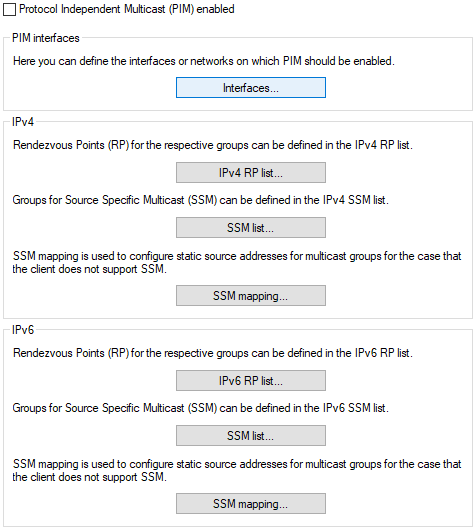PIM (RFC 7761) enables the dynamic routing of multicast packets. Here, PIM uses routing information supplied by the unicast routing protocol operated in the router, although it does this independently of the routing protocols (e.g. RIP, OSPF or BGP).
For a PIM scenario based exclusively on LANCOM routers, only the PIM SSM (Source Specific Multicast) mode is fully supported. Operating the PIM Sparse Mode requires routers or components from third-party manufacturers. The advantage of PIM SSM is that its simpler architecture scales much better, making it ideally suited for modern multicast applications such as IPTV. PIM SSM requires IGMPv3 or MLDv2 (for IPv6) on the client side and does not need an additional rendezvous point (RP), since clients directly request not only the multicast source (S) but the desired multicast group (G) as well.
Basically, PIM SSM distinguishes between two router roles: First-hop router and last-hop router. A first-hop router is directly connected to multicast IGMP or MLD clients/receivers. A last-hop router is connected directly to the multicast source. There are also other routers located between the other two router roles. PIM must always be activated on all interfaces required to perform multicast routing. IGMP or MLD must be activated on client interfaces.
- PIM Sparse Mode (ASM) with external RP from a third-party manufacturer
- Static configuration of the RP in PIM Sparse Mode
- PIM SSM in the roles of last-hop router and first-hop router
- Supports IPv4 and IPv6 PIM
- SSM mapping, where PIM SSM joins are generated from IGMPv2 or MLD messages
- PIM native over IPSec VPN without GRE tunnel
- The rendezvous point (RP) role
- Role as first-hop router for PIM Sparse, creating an automatic Register Unicast Tunnel to register a multicast source with the RP
- Dense mode, Bi-Dir mode
- Dynamic RP configuration, e.g. via Bootstrap Router (BSR) function
PIM show commands
- PIM IPv4-Groups: Shows information about joined IPv4 multicast groups
- PIM IPv6-Groups: Shows information about joined IPv6 multicast groups
- PIM IPv4-Hello: Shows extended information about PIM neighbors and the PIM Hello-State on IPv4 interfaces
- PIM IPv6-Hello: Shows extended information about PIM neighbors and the PIM Hello-State on IPv6 interfaces
- PIM IPv4-Neighbors: Shows a short overview of PIM neighbors on IPv4 interfaces. Optionally, you can use the parameter [-s] [--skip-own-info] to omit the output of your own interface.
- PIM IPv6-Neighbors: Shows a short overview of PIM neighbors on IPv6 interfaces. Optionally, you can use the parameter [-s] [--skip-own-info] to omit the output of your own interface.
Example of the necessary configuration steps
- Activate PIM globally
- An entry is required in the PIM interface table for every interface involved in multicast routing, including client interfaces and the source interface. You can use the default values.
- To enable SSM, an entry must be made in the IPv4 or IPv6 SSM table. You can use the default values.
Configuration
In order to configure PIM with LANconfig, navigate to the menu.

- Protocol Independent Multicast (PIM) enabled
- Enables or disables PIM on the device.
